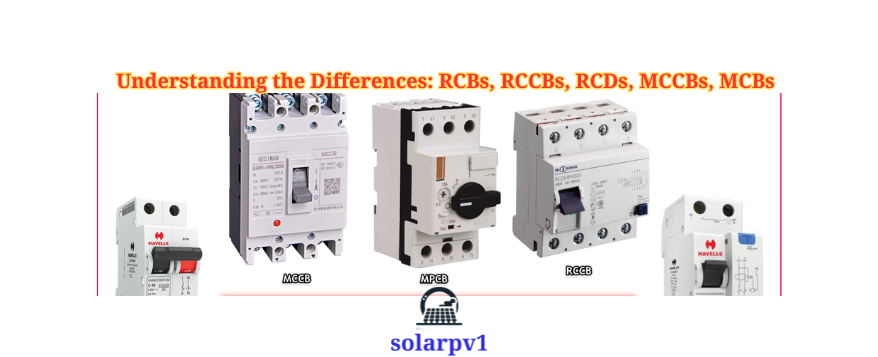Introduction RCBs, RCCBs, RCDs, MCCBs, MCB, and RCB’s
When it comes to electrical circuit protection, there are several devices that play a crucial role in ensuring safety and preventing damage. Among these devices are RCBs, RCCBs, RCDs, MCCBs, MCBs, and RCBOs. While they may sound similar, each of these devices serves a different purpose and has its own unique features. In this blog post, we will explore the differences between these devices and understand their applications in electrical systems.
1. RCB (Residual Current Breaker)
- An RCB, also known as a residual current breaker, is a device that provides protection against electrical leakage currents. It is designed to detect any imbalance between the phase and neutral currents in a circuit. When an imbalance is detected, the RCB quickly interrupts the circuit, preventing potential electric shocks.
- An RCB is typically used in residential and commercial buildings to protect individuals from electric shock hazards. It is commonly installed in areas where electrical appliances are used, such as kitchens, bathrooms, and outdoor areas. RCBs are available in different ratings to suit various applications and can be reset manually after tripping.
2. RCCB (Residual Current Circuit Breaker)
- A RCCB, or residual current circuit breaker, is similar to an RCB in terms of its function. It also detects and interrupts electrical leakage currents to prevent electric shocks. However, the main difference lies in its additional feature of overcurrent protection.
- An RCCB not only detects imbalance currents but also provides protection against overcurrents caused by short circuits or overloads. It combines the functions of a residual current device (RCD) and a circuit breaker (CB) in a single device. RCCBs are commonly used in electrical distribution boards to protect circuits and equipment from both electrical leakage and overcurrents.
3. RCD (Residual Current Device)
- A RCD, or residual current device, is another device that provides protection against electrical leakage currents. It is similar to an RCB in terms of its function and is often used interchangeably. However, there is a slight difference between the two.
- An RCB is a type of RCD that includes a built-in circuit breaker for additional protection. On the other hand, a standalone RCD does not have the circuit breaker feature and is solely focused on detecting and interrupting leakage currents.
4. MCCB (Molded Case Circuit Breaker)
- An MCCB, or molded case circuit breaker, is a device that provides protection against overcurrents caused by short circuits or overloads. It is commonly used in industrial and commercial applications where higher current ratings are required.
- MCCBs are designed to handle higher currents and provide reliable protection for electrical systems. They are equipped with thermal and magnetic trip elements to detect and interrupt overcurrents. MCCBs are available in different sizes and can be manually reset after tripping.
5. MCB (Miniature Circuit Breaker)
- An MCB, or miniature circuit breaker, is a smaller version of an MCCB. It is designed for lower current applications, typically found in residential and commercial buildings. MCBs provide protection against overcurrents and are commonly used to protect individual circuits.
- MCBs are available in different ratings and trip characteristics to suit various applications. They are compact in size and can be easily reset after tripping. MCBs are commonly found in distribution boards and offer reliable protection for electrical circuits.
6. RCBO (Residual Current Circuit Breaker with Overcurrent Protection)
- An RCBO, or residual current circuit breaker with overcurrent protection, is a combination of an RCCB and an MCB. It provides protection against both electrical leakage currents and overcurrents caused by short circuits or overloads.
- An RCBO is commonly used in applications where individual circuit protection is required, such as in residential and commercial buildings. It combines the functions of an RCCB and an MCB in a single device, offering comprehensive protection for electrical circuits.
Final Thoughts
In summary, RCBs, RCCBs, RCDs, MCCBs, MCBs, and RCBOs are all important devices in electrical circuit protection. While they may have similar functions, each device serves a specific purpose and has its own unique features. Understanding the differences between these devices is crucial for ensuring the safety and reliability of electrical systems in various applications.
